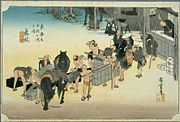
Fujieda-juku
Encyclopedia

53 Stations of the Tokaido
The are the rest areas along the Tōkaidō, which was a coastal route that ran from Nihonbashi in Edo to Sanjō Ōhashi in Kyoto.-Stations of the Tōkaidō:...
of the Tōkaidō
Tokaido (road)
The ' was the most important of the Five Routes of the Edo period, connecting Edo to Kyoto in Japan. Unlike the inland and less heavily travelled Nakasendō, the Tōkaidō travelled along the sea coast of eastern Honshū, hence the route's name....
. It is located in what is now part of the city of Fujieda
Fujieda, Shizuoka
is a city located in Shizuoka, Japan. The modern city was founded on March 31, 1954. As of February 2009, the town has an estimated population of 142,023 and a density of 732 persons per km². The total area is 194.03 km².-Geography:...
, Shizuoka Prefecture
Shizuoka Prefecture
is a prefecture of Japan located in the Chūbu region on Honshu island. The capital is the city of Shizuoka.- History :Shizuoka prefecture was formed from the former Tōtōmi, Suruga and Izu provinces.The area was the home of the first Tokugawa Shogun...
, Japan
Japan
Japan is an island nation in East Asia. Located in the Pacific Ocean, it lies to the east of the Sea of Japan, China, North Korea, South Korea and Russia, stretching from the Sea of Okhotsk in the north to the East China Sea and Taiwan in the south...
.
History
Fujieda-juku was a castle townCastle town
A castle town is a settlement built adjacent to or surrounding a castle. Castle towns are common in Medieval Europe. Good example include small towns like Alnwick and Arundel, which are still dominated by their castles...
of the Tanaka Domain
Tanaka Domain
' was a tozama Japanese feudal domain of the Edo period, located in Suruga Province, centered on what is now Fujieda City, Shizuoka Prefecture...
. Additionally, it was a post station
Shukuba
were post stations during the Edo period in Japan, generally located on one of the Edo Five Routes or one of its sub-routes. They were also called shukueki . These post stations were places where travelers could rest on their journey around the nation...
along the Unuma Kaidō, which ran to the salt-producing area of Sagara
Sagara, Shizuoka
was a town located in Haibara District, Shizuoka, Japan.On October 11, 2005 Sagara was merged with the town of Haibara, also from Haibara District, to form the new city of Makinohara, and thus no longer exists as an independent municipality....
. It flourished as a commercial town and, at its prime, hosted 37 hatago
Hatago
were Edo period lodgings for travelers at shukuba along the national highways, including the Edo Five Routes and the subroutes. In addition to a place to rest, hatago also offered meals and other foods to the travelers...
.
The classic ukiyoe print by Ando Hiroshige (Hoeido edition) from 1831-1834 depicts the actual business of the shukuba as a relay station to change horses and coolies to permit the rapid transmission of high priority messages and goods between Edo and Kyoto.
At the beginning of the Meiji period
Meiji period
The , also known as the Meiji era, is a Japanese era which extended from September 1868 through July 1912. This period represents the first half of the Empire of Japan.- Meiji Restoration and the emperor :...
, when the Tōkaidō Main Line
Tokaido Main Line
The is the busiest trunk line of the Japan Railways Group , connecting Tōkyō and Kōbe stations. It is long, not counting its many freight feeder lines around the major cities...
railway was being built, residents were worried about the smoke and ash from the newly developed steam locomotive
Steam locomotive
A steam locomotive is a railway locomotive that produces its power through a steam engine. These locomotives are fueled by burning some combustible material, usually coal, wood or oil, to produce steam in a boiler, which drives the steam engine...
s would ruin their green tea
Green tea
Green tea is made solely from the leaves of Camellia sinensis that have undergone minimal oxidation during processing. Green tea originates from China and has become associated with many cultures throughout Asia. It has recently become more widespread in the West, where black tea is traditionally...
crop, and decided to block construction of the line. As a result, Fujieda Station
Fujieda Station
is a railway station in Fujieda, Shizuoka Prefecture, Japan, on the Tōkaidō Main Line. It is located 200.3 rail kilometers from Tokyo Station, and is operated by Central Japan Railway Company .- Station history:...
(now part of Central Japan Railway Company
Central Japan Railway Company
The is the main railway company operating in the Chūbu region of central Japan. It is officially abbreviated in English as JR Central and in Japanese as . Its headquarters are located in the JR Central Towers in Nakamura-ku, Nagoya, Aichi Prefecture.The company's operational hub is Nagoya Station...
) was built approximately three kilometers from the town, which led to a decline in prosperity for the old town. However, after Fujieda became a city, its area expanded greatly and has become an industrial community. Additionally, it serves as a bedroom community to Shizuoka
Shizuoka, Shizuoka
is the capital city of Shizuoka Prefecture, Japan, and the prefecture's second-largest city in terms of both population and area. It became one of Japan's 19 "designated cities" in 2005.-Geography:...
.
Further reading
- Carey, Patrick. Rediscovering the Old Tokaido:In the Footsteps of Hiroshige. Global Books UK (2000). ISBN 1901903109
- Chiba, Reiko. Hiroshige's Tokaido in Prints and Poetry. Tuttle. (1982) ISBN 0804802467
- Taganau, Jilly. The Tokaido Road: Travelling and Representation in Edo and Meiji Japan. RoutledgeCurzon (2004). ISBN 0415310911

